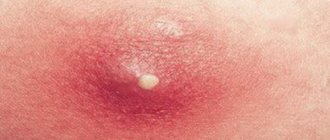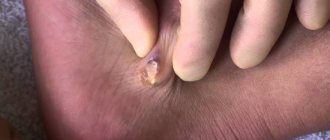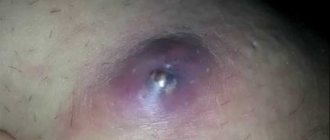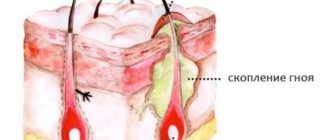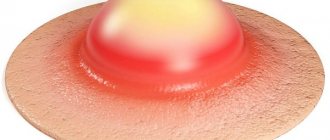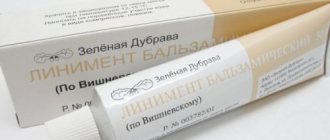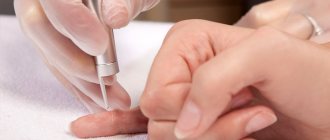A furuncle or boil is an acute inflammation of the hair follicle or sebaceous gland caused by Staphylococcus aureus. Most often it appears on the head, face, lower neck, shoulders, armpits, and thighs. It can be external or internal. The first type appears on the surface of the skin, and the second - in its depths. The latter often does not reveal itself in any way and is therefore life-threatening.
An abscess occurs as a result of microscopic injuries to the skin (scratches, abrasions, cuts), disruption of the sweat and sebaceous glands, digestive organs, poor nutrition, and weakened immunity.
Causes of ulcers
The development of abscesses can be caused by penetration of pathogenic microflora through the skin or infection. The development of an abscess is associated with the human immune system and the specific causative agent of the disease. An abscess can easily occur in various parts of the body: in the liver, throat, tonsils, and even brain tissue.
Often, ulcers appear on the body after serious illnesses such as influenza, pneumonia, tonsillitis and sepsis. The abscess can be one or several pieces. There are small and large rashes. And abscess is divided into acute and chronic.
Soft tissue abscesses can occur after minor bruises. Often infection occurs against a background of weakening of the body.
Stages of ulcer maturation
The formation of an abscess occurs as follows:
- Due to skin damage, a staphylococcal infection enters the body.
- A capsule appears at the affected area, which prevents damage to other tissues. Redness and hardening appear at the site of infection.
- There is purulent discharge in the capsule.
- After 7 days, the purulent masses come out, after which the wound healing process and restoration of skin tissue occurs.
If the suppuration is deep, then it has the ability to penetrate deep into the skin. All this can lead to sepsis, the treatment of which can be lengthy and not always effective.
In medicine, a rule is often followed: if pus is seen, it is immediately eliminated. The abscesses are opened under general or local anesthesia. Next, the wound is cleaned and drainage is installed to drain the pus. At the end of this procedure, a gauze bandage is applied, which will have to be changed more than once.
When all the pus has come out of the wound, the drainage can be removed. In parallel, the doctor prescribes medications that help the wound heal quickly. But minor suppuration can be easily eliminated at home.
Squeezing a boil: is it possible to squeeze it?
The nature of the boil is such that it must ripen and open on its own. The pus that accumulates in the hair follicle breaks out over time. The patient can only speed up the maturation process with the help of medications, heating and physiotherapeutic procedures. In the last article we wrote how to quickly treat a boil at home, we recommend reading it.
But squeezing out an unripe boil on your own is extremely dangerous.:
- there is a risk of developing an abscess and phlegmon (find out what this is here);
- furunculosis may appear - multiple purulent rashes;
- the possibility of sepsis due to infection entering the bloodstream cannot be excluded;
- An open wound can get infected, resulting in new purulent abscesses.
Repeated boils form if the source of inflammation in the wound is not completely removed. If the abscess does not break through, and the patient tries to squeeze it out, any complications may develop.
When the root of the boil is located deep, then if you put pressure on it, the pus may come out not to the surface, but inside. Then, through the bloodstream, it will spread the infection throughout the body.
It is very dangerous to trust the advice of so-called “experts” who allegedly share their own experience in treating various diseases. And today there are a great many of them on the Internet. For example, videos are shown teaching how to squeeze out a boil with a bottle at home. The essence of the procedure is this: the neck is applied to the chiryak, then a strong clap on the bottom and that’s it, the “operation” is completed.
But such a risky method can only help if the boil is shallow and almost ripe. And then, the success of the procedure is not at all guaranteed. It is especially dangerous to try to squeeze out a boil on the face; this is fraught with the development of purulent meningitis, meningoencephalitis, and sepsis. We talked about the nuances of treating a boil on the face here.
What to do if a purulent abscess opens on its own:
- the wound is treated with an antiseptic drug, carefully removing any remaining pus;
- it is necessary to make sure that the necrotic core has come out (this is a dense yellow-green substance), otherwise a new inflammatory process will develop;
- the affected area is smeared with an ointment with an antibacterial or healing effect (which drugs to use should be determined by the attending physician);
- apply a sterile bandage, which should be soaked in sodium chloride solution;
- the area around the boil is treated with brilliant green, fucorcin or alcohol.
If the necrotic core does not come out of the wound, you need to urgently seek medical help to prevent the spread of infection into the tissues.
Read our article about how to treat boils on the eye.
If you want to know what to do if you have an abscess on your finger near the nail, follow this link.
How to speed up the maturation of the purulent core?
It is important to know that any damage to the skin, except for a sterile medical instrument, is associated with infection. If the first signs of inflammation are noticeable, you should not allow the wound to close and constantly moisten it with hydrogen peroxide. To speed up the process of maturation of the purulent core, you need to use medications. All of them are sold in pharmacies at low prices.
At home, patients can treat an abscess with the following medications:
- Ichthyol ointment,
- Levomekol,
- Streptocidal ointment,
- Vishnevsky ointment.
Before applying the ointment, you should treat the skin with hydrogen peroxide, and then apply a clean bandage. The ointment should be changed according to the instructions for the product used.
How to install drainage after a boil
Drainage is made from turunda - a small latex strip from a glove that is used to dry the cavity of a boil or drain a wound after removing a boil.
The drains are prepared in advance: the nurse cuts strips of the required length and width from the glove. After cleaning and disinfecting the wound crater using tweezers and a probe, the doctor places a drainage into its cavity. An antimicrobial ointment, usually Levomekol, is applied on top. It prevents the proliferation of pathogenic flora and protects against recurrence of the boil after its removal.
Daily replacement of latex drainage is not necessary. It is usually used 2-3 days after the boil opens.
When the crater is cleared of purulent contents after removal, and the wound is covered with granulation tissue, the strip is removed in a dressing room, observing the rules of asepsis.
When installing drainage into the cavity of the boil, it is necessary to apply a bandage and secure it with breathable material. The strip in the wound is not sutured; it is needed to prevent the cavity from closing. Then you need to adhere to the usual care for the affected area: ointments, solutions and other means prescribed by the doctor to speed up recovery.
Traditional medicine recipes
Traditional medicine has proven itself well in the treatment of ulcers. There are a huge number of useful recipes that help quickly break through and heal affected areas of the skin. Using this technique, you can reduce pain and speed up the process of skin regeneration.
- Rye bread has been used for a long time to treat ulcers. To do this, you need to grind fresh rye flour bread in your mouth along with salt. The resulting pulp should be applied to the inflamed area and tied with a bandage so that it does not fall off. Using this recipe, you can speed up the process of breaking out the abscess and its healing.
- Honey has many beneficial properties. Its benefit lies in wound healing. To make the abscess resolve faster, you need to make a cake from equal amounts of flour and honey. This remedy effectively helps in the first and second stages of furunculosis.
- Although they say that an abscess cannot be heated, there is a recipe that refutes these rumors. Onions are baked in the oven and then applied to the inflamed area. The bulb needs to be changed every 4 hours. If you use this recipe, the abscess can quickly resolve.
- Ash mustache in a pot has many beneficial properties. It heals purulent wounds well. First you should select a thick rod and peel it. Next, the golden mustache is cut lengthwise, heated and applied to the inflamed area. You can also mix the pulp of this plant with honey and apply it to the inflammation overnight. In the morning, the bandage should be changed, and the affected area should be treated with any ointment to prevent the formation of purulent discharge.
- Laundry soap also helps eliminate inflammation perfectly. It needs to be grated and mixed with 300 ml of water. After this, you need to cook it until all the liquid has evaporated. The finished pulp is cooled, placed on a bandage and applied to the affected area.
- Compresses are made from willow decoction. The recipe consists of 20 grams of crushed willow bark, which is mixed with a glass of boiling water. After this, you need to heat everything in a container over low heat for 30 minutes. The prepared pulp should be applied to the inflamed area with a gauze bandage for a short time.
- Plantain can be used to stop bleeding from an abscess and for long-term non-healing wounds. This ingredient can be used as infusions and decoctions. In practice, a paste of plantain leaves is often used. It is applied to the inflamed area so that the wound heals.
Patients should treat the abscess comprehensively, because against the background of reduced immunity, chronic furunculosis often develops, which after treatment leaves large scars on the skin. The protective function of the body is supported with the help of vitamins, immunomodulators and a healthy lifestyle. Patients are required to adhere to hygiene rules. Those women who often have inflammation of the hair follicles are required to refuse depilation. After all, this procedure leads to ingrown hairs.
Accumulation of pus under the skin: ways to draw out the contents of an abscess
Most pathological processes on the surface of the dermis are accompanied by liquid or solid formation. Inflammatory foci can be represented by boils, carbuncles, and abscesses. To draw out pus from under the skin, you will need special medications, adherence to diet, work and rest.
Features of pulling pus from open and closed wounds
The formation of purulent masses is a kind of protective reaction to the contact of infectious agents with damaged skin. The proliferation of microorganisms occurs under the dermis and on its surface. The immune system signals blood cells about pathological processes. Leukocytes are sent to the site of inflammation. The reaction of bacteria binding to red particles ends in suppuration of the skin area.
In medicine, closed and open wounds are distinguished. The former have no communication with the external environment. The second ones are in contact with her.
Both pathological processes on the skin are treated according to a specific algorithm. The choice of drug that draws out the contents will depend on the type of wound.
The general rules for the treatment of open and closed wounds on the skin with pus are the principles:
- The application of the drug with pulling properties occurs under sterile conditions. The doctor must treat the working surface of the skin and hands. If the patient is treated for pus on his own, similar principles should be followed.
- If an allergic reaction to the drug occurs, stop its use. The drug is replaced with another medication with stretching properties.
- Closed wounds at the stage of abscess formation cannot be treated with Vishnevsky ointment. Liniment can cause increased discharge of pus. The pathological contents spread into the deep structures of the skin and into neighboring tissues.
You can effectively remove pus from a pimple at home if you follow the rules.
Medications for drawing out pus and methods of their use
There are a large number of drugs on the pharmaceutical market that can be applied to an abscess to draw out pus at home. They are available without a prescription and are characterized by a minimal risk of side effects. For convenience, gels, ointments, patches, and solutions are used. They have a disinfectant, anti-inflammatory, antimicrobial effect on the skin.
Ointments
In terms of effectiveness among ointments, Vishnevsky's liniment ranks first. The drug contains three active components. They are able to draw out liquid and solid pus from the source of infection, enhancing each other’s properties. Vishnevsky ointment relieves inflammation on the skin, reduces the number of pathogenic microorganisms in the lesion, improves blood circulation and metabolism inside the vesicle.
The main advantage of liniment is the rapid opening and complete resorption of the abscess. The ointment can draw out old pus that lies deep in the skin. After several uses of the drug, deep cleansing and regression of the disease are observed.
Vishnevsky ointment is not suitable for people with allergies or bronchial asthma. The specific smell of the product can cause health problems.
To draw out white pus from a pimple, the area of inflammation is lubricated 2 times a day. If the pathological process is deep, apply compresses with ointment to the skin twice a day.
Ichthyol helps to draw out pus from a wound. It can be used for internal and external skin pathologies. It is safe to use at home. In order to draw out the contents of the abscess, it is lubricated with the product 2-3 times a day.
Tetracycline ointment fights many pathogenic microorganisms and effectively treats purulent wounds on the skin.
Plasters
Special plasters cleanse the deep layers of skin from pus and protect wounds from microbial infection. Advantages of the product:
- The bandage is removed painlessly.
- No allergic reaction occurs.
- The patch is able to draw out a large amount of pus from a skin wound. Under its action, reparative processes are stimulated.
The instructions clearly and clearly describe how to use the bandage. The patch is glued to the skin with the mesh side. It is fixed with gauze or bandage. For convenience, the bandage can be cut along the contours to reduce its size. The patch is easy to use in hard-to-reach places: on the earlobe, between the fingers. The bandage is applied for the whole day. Then it is replaced by a new one.
Other
Levomekol gel and Sintomycin liniment can be applied to the area of a closed and open wound. The first drug is used to draw out liquid pus from a lesion on the skin, heal the resulting wound, and suppress the activity of pathogenic flora.
Levomekol is suitable for the treatment of deep and superficial abscesses. It is widely used in gynecological and surgical hospitals. It can draw out old pus from deep lesions. The ointment is applied in a thin layer to the inflamed skin 2-3 times a day.
Liniment Syntomycin is used to treat minor lesions of the dermis. It can draw out solid and liquid pus and speed up the healing process. The drug contains an antiseptic and antibiotic. The latter destroys the cell wall of the microbe, the inflammatory process on the skin subsides. The ointment is applied in a thin layer 2-3 times a day.
Traditional methods of treating a purulent abscess before a breakthrough
To get rid of ulcers on the skin using folk remedies. Regular onions and aloe produce results no worse than imported drugs. Effective home recipes for drawing out old pus from a wound are presented below.
Aloe
The flower is used to treat skin wounds. The plant has antiseptic properties and reduces typical symptoms of inflammation. Aloe is able to draw out purulent masses from deep and superficial layers. The abscess opens 2-3 days after regular bandaging.
For the compress you need a whole leaf of the plant, from which the protective film is removed. The plant is applied to the area of skin with pus, fixed with gauze or bandage. The procedure is carried out 2 times a day. The course of treatment is 3 days. If aloe fails to draw out the white pus, other types of compresses are used. The use of pharmaceutical drugs is added to the procedure.
Onion
The baked vegetable can be applied to the abscess to draw out the white pus from the wound. The healing onion for the skin is prepared in the oven, in a frying pan or in the microwave.
The fruit is cut in half and placed in a heating device for 10 minutes. In the oven it bakes 6-7 at 180 degrees. For cooking in a frying pan, do not use vegetable oil or animal fat.
The two halves are placed on a hot surface and baked over low heat for 10 minutes.
Do you need advice from an experienced doctor? Get a doctor's consultation online. Ask your question right now.
Ask a free question
After cooling, the onion is applied to the abscess with pus. The baked vegetable is fixed with circular rounds of bandage. After 2-3 hours, the bandage on the skin is changed. Onions can draw out white pus in a short period of time.
If it is not possible to bake the onion, it is boiled. After cooking and cooling, apply compresses.
Garlic
Garden garlic is used to treat mild boils and can draw out liquid pus from the affected dermis in 2-3 days. The main advantage of the plant is its ability to disinfect the surface of the skin.
To draw out and get rid of pus using garlic, you need to peel its head and bake it in the oven.
The prepared raw materials are mixed with grated laundry soap and heated in the microwave. The mass is converted into a cake. When warm, it is applied to the area of skin with pus.
After 4 hours, the garlic cake is replaced with a new one. The product will be able to draw out the contents if you use it 4-5 times a day.
Which remedies can be used to draw out pus from a pimple?
If the abscess is located on the skin of the face, Vishnevsky's liniment and ichthyol ointment may not be suitable. They have an unpleasant odor. Being close to the nose causes discomfort.
To draw out hard pus from a pimple, apply aloe, compresses with salt, and Levomekol gel. Under the influence of the funds, the bubble matures and breaks through. They are not dangerous to the body and rarely cause side effects.
To treat acne on the skin, you can use drugs from the pharmacy: Zinerit, Skinoren. Both drugs have bactericidal and anti-inflammatory properties. They are easy to apply and work quickly.
Precautions and when to see a doctor
You can remove pus from the skin at home if you follow the following precautions:
- You cannot puncture the abscess. Do not squeeze out the contents from the infiltrate.
- It is prohibited to change the recommended dosage, frequency of use of drugs, folk remedies.
- If after 3 days there is no effect - the pus does not drain out - you should abandon home treatment and consult a surgeon. He will puncture or cut the bladder, remove the pathological fluid, and rinse the inflamed area with a syringe. The operation allows you to quickly get rid of the purulent plug and relieve pain.
- To prevent the bubble from growing or bursting, treatment and drawing out the contents must begin in the early stages of the disease. If an abscess occurs in the facial area, you should consult a doctor for advice. It will not be possible to draw out pus at home due to the high risk of complications.
Abscesses of any location should be examined in a hospital setting. Late appeal may result in negative consequences.
The article has been reviewed by the site editors
Source: //VashaDerma.ru/dermatologiya/abstsess/vytyanut-gnoj-pod-kozhej
Surgical methods for opening ulcers
The main method of treating ulcers is surgical method. An abscess can be eliminated by opening the capsule containing pus. Sometimes doctors limit themselves to puncture, pump out the pus, and inject an antibiotic into the affected area. The affected area, where there was previously pus, must be washed with a solution of Rivanol or Furacilin.
Skin care after surgery
After the operation, you should not pick at the inflamed area to avoid infection. To change the old dressing, the patient will need a bandage and hydrogen peroxide to eliminate the infection. The wound must be treated until it heals. Before carrying out all operations, it is important not to forget to wash your hands.
In order not to encounter severe forms of boils, prevention of pustular skin diseases is necessary. After all, this is how you can prevent the appearance of complex abscesses.
source
Prevention
Preventive measures that are aimed at preventing the appearance of a boil (carbuncle) should include a correct, healthy lifestyle. In addition to physical education and sports, follow simple rules:
- Follow the rules of personal hygiene.
- Take care of your skin if you sweat excessively. Use products containing farnesol - soap (“UtraA-C”, “Faith in nature”), antiperspirant (Rexona, Lady Speed Stick cream), deodorant (“Nivea”, “Dove”).
- If the skin is damaged, treat it with antiseptic agents (70% alcohol, brilliant green, iodine).
- Play sports, take a walk in the fresh air in the evenings.
- Strengthen your immune system. Eat more fresh vitamins (vegetables, fruits, greens).
Opening an abscess
Some patients ask: “How to open an abscess correctly?” Opening an abscess at home is prohibited. This event can cause serious complications.
An autopsy can cause the following complications:
- Skin furunculosis.
- Secondary abscess formation.
- Introduction of a second pathogen into the infection zone.
- Thrombosis of the cavernous sinus when the abscess is localized on the face.
- Sepsis is the entry of a pathogen into the blood.
Since autopsy cannot be performed at home, you should seek surgical help from a specialist.
Small abscesses can be treated conservatively. To “break through” the abscess, use one of the following drugs:
- Ichthyol ointment.
- Levomekol.
- Vishnevsky ointment.
- Baneocin.
What to do if you don’t have funds at hand? Some adherents of traditional methods of therapy recommend numerous recipes for alternative medicine.
Ichthyol ointment
The abscess matures faster when using the popular ichthyol ointment. This drug contains the substance ichthammol. The product has a number of positive effects:
- Kills bacteria in the area of inflammation.
- Causes irritation of nerve receptors, which reduces their sensitivity and reduces pain.
- Causes protein denaturation, which contributes to the accumulation of purulent masses.
- It is very well absorbed by the skin and mucous membranes, which allows the drug to penetrate into closed ulcers.
How to remove an abscess using ichthyol ointment? It must be applied externally 2 times a day. The effect is enhanced when applied under a sterile bandage.
A contraindication for use is an allergy to the active substance; in other cases, you can safely apply the medicine topically to the skin.
Levomekol
If the abscess does not break out on its own, you can use Levomekol ointment. This drug contains the antibiotic chloramphenicol and the antimicrobial agent methyluracil.
Due to the combined action of two strong agents, a rapid therapeutic effect is achieved:
- Medicines penetrate the skin and end up inside the purulent cavity.
- Due to the antiseptic effect, the destruction of pathogenic bacteria is achieved.
- The volume of purulent masses increases, which provokes its release to the surface of the skin.
- The abscess will break out fairly quickly with regular use of the ointment.
Small boils do not need to be opened by a doctor if you have this antibacterial ointment on hand.
Levomekol draws out pus well if you use it as follows:
- Apply a small strip of ointment to a sterile bandage folded several times.
- Apply it to the area of inflammation.
- A small aseptic bandage is applied on top.
- Dressing is done daily.
- The traction bandage should not become wet or dirty.
If you have a large abscess, you should consult a doctor.
Vishnevsky ointment
One of the best remedies that helps break out an abscess is Vishnevsky ointment. This substance with a characteristic odor contains birch tar, castor oil and xeroform. The drug occupies an intermediate position between a medicine and a folk remedy. The ointment was developed by a doctor and has been used in medicine for a long time.
The main property due to which the drug is used for abscesses is the ability of the ointment to accumulate pus. The medicine acts not only on microbes and kills them, but also on skin proteins. Under the influence of the drug, the abscess quickly opens and pus comes out of the skin.
Use the remedy for suppuration as follows:
- The ointment is applied to a gauze square and applied to the site of inflammation.
- An aseptic bandage is applied on top.
- The bandage should be changed 2 times a day.
- Remove the dressing if dirt accumulates on it or if it gets wet.
- Do not apply a large amount of product, which will saturate the bandage through.
- If you do not change the bandage for a long time, the ointment will dry out and a crust will form on top of the inflammation.
- This bandage can be removed only after wetting the crust with a chlorhexidine solution.
If you have several boils on the skin, you should contact a qualified specialist.
Baneocin
Abscesses also open well when treated with the popular antibacterial ointment - Baneocin. The drug consists of two antibiotics: bacitracin and neomycin. These substances work well with boils both in the ripening stage and if they burst on the surface of the skin.
The product is used as follows:
- Apply to the affected area of skin 4 times a day.
- Can be applied under a bandage to prolong the effect of the product.
- The product does not need to be washed off with water; you must wait until the drug is absorbed.
The drug is actively absorbed into the bloodstream and has a number of contraindications. You must read the instructions before use. In particular, it is used with great caution during pregnancy and breastfeeding.
Folk remedies
Many patients prefer to use predominantly traditional methods of treatment. Healers recommend using the following recipes to open ulcers:
- An onion baked in the oven is applied to the site of the abscess and secured with a bandage.
- Using laundry soap - soap the bandage and secure it overnight.
- Laundry soap is mixed with beeswax, honey and vegetable oil. It is heated and applied as an ointment.
- The leaves of the indoor ficus are scrolled in a meat grinder, applied to the abscess and secured with a bandage.
- Aloe juice is squeezed onto the surface of the skin and secured under a bandage up to 3 times a day.
- An alcoholic tincture of garlic helps the abscess break through with regular use.
These and numerous other recipes from traditional healers should be used after consulting a doctor.
How to get rid of an abscess without getting blood poisoning
The word abscess is translated from Latin simply as an abscess.
Doctors use this Latin term to describe an active inflammatory process in which a cavity filled with pus forms in living tissue. Tavarius/Shutterstock
An abscess can occur in any part of the human body, including internal organs. But most often it affects the skin in the armpits, groin, area around the anus, base of the spine and gums near the teeth.
Inflammation around the hair follicle can also lead to the formation of an abscess - this type of abscess is commonly called a boil.
How to tell if you have an abscess
Symptoms of an external abscess developing inside the skin are usually obvious:
- it looks like a dense swelling, a “bump” that has grown under the skin;
- touching him is painful;
- the skin on the affected area turns red and feels hot to the touch;
- not always, but quite often you can see an accumulation of white or yellow pus under the stretched skin.
Extensive subcutaneous abscesses may also be accompanied by fever.
Abscesses that arise on internal organs or in the tissues between them are more difficult to recognize. Signs of an abscess in this case are vague and may vary depending on which organ is affected. For example, a liver abscess is often accompanied by jaundice, a yellowing of the skin of the body and the whites of the eyes. A lung abscess causes coughing and shortness of breath.
If we talk about the general and most common symptoms of an internal abscess, here they are:
- discomfort and pain in the area of the organ on which the abscess occurred;
- temperature increase;
- loss of appetite up to complete reluctance to eat;
- active sweating;
- distinct weakness.
Small abscesses often resolve on their own. However, much more negative scenarios are also possible.
When to Seek Help Quickly
Consult your physician or surgeon immediately if:
- the diameter of the subcutaneous abscess exceeds 1 cm;
- the abscess continues to grow and becomes more and more painful;
- inflammation occurs in the groin or anus;
- the abscess is accompanied by an increase in temperature.
Go to the emergency room or call 911 if:
- An abscess with a diameter of more than a centimeter appeared on the face.
- The temperature rose to 38.8 °C and above.
- You notice red streaks under the skin that spread outward from the abscess.
- In the area between the abscess and the breast, the lymph nodes were enlarged. For example, an abscess on the leg can cause enlarged lymph nodes in the groin area.
Such symptoms indicate that there is a high risk of blood poisoning. And this is a deadly condition.
What to do if you have an abscess
Ideally, any abscess, even if it looks small and relatively harmless, should be shown to a doctor - a therapist, surgeon or dermatologist.
The specialist will examine the abscess, assess its location and size, and analyze your health condition. And after that he will give recommendations on how and with what to treat the abscess in your particular case.
Please note: antibiotics or surgical removal of the abscess may be required.
Until you see a doctor, you can try to alleviate the condition with home methods.
Apply warm compresses
They will help reduce pain and accelerate the maturation of the abscess. Apply gauze soaked in warm water to the affected area 3-4 times a day for 15 minutes.
Use ointments
Apply antiseptic ointments with a pulling effect to the abscess. To find out which is better and safer to use in your case, consult your doctor.
Don't forget about antiseptic
If the abscess opens on its own, wash the wound with antibacterial soap and treat with any antiseptic, possibly alcohol-based. Then apply an antibacterial ointment (for example, levomekol or tetracycline) and apply a bandage. Wash the wound with warm water 2-3 times a day and apply warm compresses until it heals.
Trying to squeeze out the pus
Pressure can drive it deeper, which means the abscess will only increase in size.
Piercing an abscess with a needle
You can accidentally damage a blood vessel, which means pus will enter the bloodstream - with the expected consequences of sepsis.
Rely only on home methods
Do not continue home treatment if the abscess does not decrease in size (much less if it continues to grow) within a couple of days. Consult a physician as soon as possible.
Ignore general health
Do not take risks, but consult a doctor immediately if an abscess develops against the background of problems with the cardiovascular system, iron deficiency anemia, diabetes, any problems in the immune system, or taking drugs that suppress the immune system. In this case, the body's defenses may not be enough to defeat the infection on its own.
Source: //Lifehacker.ru/abscess/
What to do if an abscess breaks?
When it is possible to draw out the contents of the abscess, it is necessary to carry out a number of measures that will help speed up healing. These include:
- Removing purulent masses using a sterile turunda or napkin.
- Wash the wound with an antiseptic solution - chlorhexidine or hydrogen peroxide.
- Use of antibacterial ointments. Baneocin and Levomekol can be used. These products can be replaced with alternative ones; during this period, the degree of absorption of the drug into the skin is not so important.
- Applying an aseptic bandage to the wound and regular dressings. Prevents secondary infection.
If a person’s condition worsens, symptoms of intoxication and fever appear, it is necessary to consult a doctor.
source
Opening a paratonsillar abscess
When harmful bacteria enter the body, it responds with a universal protective reaction - inflammation. Under certain circumstances, inflammation can become purulent. Pus is formed - a thick liquid that contains a lot of protein, dead leukocytes and microbial cells. If enough pus accumulates in one place, an abscess occurs, or, in simple words, an abscess.
Abscesses can appear in any part of the body, even in the bones. Most often they form under the skin, in the armpit, groin, genitals, anus, and other places. There are abscesses under the mucous membrane (for example, on the gum, if a carious tooth is not treated for a long time, or a retropharyngeal abscess - inflammation of the fatty tissue behind the pharynx), in internal organs: in the liver, spleen, kidneys, lungs, etc.
Most often, surgeons have to deal with subcutaneous abscesses. We will talk about their treatment below.
In what cases should a boil be cut out?
Mechanical removal is a last resort measure to get rid of a boil, which is used only when absolutely necessary.
Indications for eliminating an abscess:
- The location of the boil is in an area of constant friction. It is necessary to exclude the influence of external factors on the painful area.
- The boil does not break through on its own. Sometimes the internal lump enlarges without the appearance of a purulent head. To exclude an internal breakthrough, the abscess is surgically removed.
- Symptoms of acute intoxication are increased body temperature, nausea, weakness, loss of consciousness.
- Visible complications of furunculosis are carbuncle, abscess, phlegmon.
The decision to remove the boil is made by the attending physician based on diagnostic testing and laboratory tests.
Self-cutting or extrusion without diagnosis is dangerous and can lead to complications.
Is it possible to cope with an abscess on your own?
In principle, if the abscess is less than 1 cm in diameter and does not cause much concern, you can try to deal with it yourself. Warming compresses for 30 minutes 4 times a day help.
Under no circumstances should you try to “squeeze out” an abscess. By pressing on the cavity with pus, you create increased tension in it, which contributes to the spread of infection. You cannot pierce an abscess with a needle. The sharp tip of the needle can damage healthy tissue or blood vessels underneath the pus. Malicious microbes will not fail to take advantage of this opportunity and rush to develop new “territories”.
If you have something resembling an abscess on your skin, it is better not to delay a visit to the surgeon. Especially if:
- the abscess is very large or there are several of them;
- you feel unwell, your body temperature has risen to 38°C or more;
- an ulcer appeared on the skin;
- a red line appears from the abscess on the skin - this indicates that the infection has spread to the lymphatic vessel and lymphangitis has developed.
Is it possible to cure an abscess without opening it?
Even the ancient Greek doctor Hippocrates liked to say: “where there is an abscess, there is an incision.” Since then, little has changed in the principles of abscess treatment.
Why does the abscess need to be opened? The human body is designed very wisely; it usually gets rid of everything unnecessary. If pus has accumulated somewhere, this indicates that natural mechanisms were ineffective. The body does not know how to remove it. In this case, the cavity with pus becomes like a time bomb. Pathogenic microbes can spread beyond the abscess, sometimes leading to severe complications, including sepsis.
The best solution in this situation is to release the pus through the incision. As a rule, after this, improvement occurs quickly and the healing process begins.
After opening the abscess, the surgeon may prescribe antibiotics, but not all patients need them.
How is an abscess opened?
The operation is usually performed under local anesthesia. You will feel virtually no pain. The doctor will make an incision and clean the wound from pus - using a special suction, or manually, armed with a gauze pad.
Once the wound is clean, the surgeon will insert a finger or surgical forceps into the wound to check if there are still pockets filled with pus. Sometimes there are partitions inside the abscess that divide it into two, three, or more “rooms.” All partitions need to be destroyed and all the pus released.
The wound is washed with an antiseptic solution. But they are in no hurry to sew it up. Pus may again accumulate under the stitches. The cavity should be left open so that it is better cleaned and heals faster. To drain excess fluid, drainage is left in it - a strip of latex, one end of which is released outside. Subsequently, dressings are carried out with antiseptic solutions, healing and antibacterial ointments.
source
Chiryak opening operation
The more common and traditional method of removing a boil is surgery. The operation is performed under local anesthesia. But today a more modern, gentle way of dealing with purulent abscesses is possible - with the help of a laser. Below we will talk about these methods in more detail.
Surgical intervention
Excision of the boil is carried out only after it has fully matured. The operation lasts on average no more than an hour and consists of several stages:
- Anesthesia - local anesthesia is used, the medicine is injected under the skin from several sides of the boil.
- After the anesthetic takes effect, the surgeon makes an incision at the apex of the abscess.
- Then the cavity of the boil is cleared of purulent masses, and the doctor must also completely remove the necrotic core.
- The wound is washed with hydrogen peroxide or another antiseptic.
- If necessary, the doctor installs a drainage to ensure the drainage of remaining purulent masses.
- An antibacterial agent is applied to the wound and covered with a sterile bandage, which is secured with a plaster.
In surgery, such operations are performed on an outpatient basis, after which the patient is sent home. He should visit the doctor daily for examination and dressings. An additional course of antibiotics is often prescribed. We have a separate article on antibiotic treatment for boils.
The option of hospitalization of the patient is considered in case of localization of boils on the face in order to prevent severe brain damage (in particular, purulent meningitis), which threatens the patient’s life.
Using a laser
Today, the use of laser is proposed as a worthy alternative to surgical removal of boils. This technique is newer and more progressive, it has many advantages. And there is, perhaps, only one drawback - the price, which is not affordable for all categories of patients.
Laser removal is generally similar to conventional surgery, but instead of using a scalpel, the skin is cut with a laser beam. What are the advantages of this technology:
- the procedure is virtually painless, so no anesthesia is required;
- the surface layer of the skin and adjacent soft tissues are not damaged;
- There is no bleeding during the procedure, since blood vessels are not damaged;
- there is no risk of recurrence of the infectious inflammatory process;
- tissue regeneration occurs quickly, accelerating the healing process;
- in the period after surgery, no dressings or additional wound treatment are required;
- marks on the skin in the form of barely noticeable scars quickly resolve without the use of medications.

